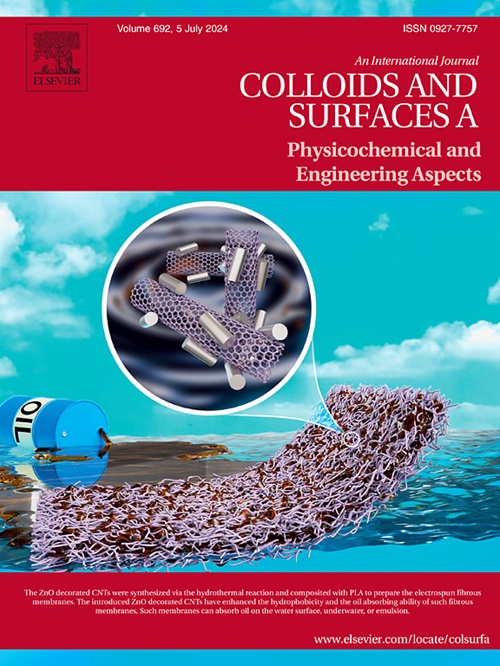高性能对称超级电容器用核桃绿皮多孔高比表面积碳材料的可控构建
IF 4.9
2区 化学
Q2 CHEMISTRY, PHYSICAL
Colloids and Surfaces A: Physicochemical and Engineering Aspects
Pub Date : 2025-04-28
DOI:10.1016/j.colsurfa.2025.137064
引用次数: 0
摘要
虽然生物质可以用来制备超级电容器的碳材料,但未经改性的碳材料具有较低的电化学性能。此外,炭化过程中生物质反应的复杂性导致了比表面积和孔隙结构的不规则变化。为此,以核桃青皮为碳源,以KHCO3为活化剂制备高比表面积多孔碳材料,实现了碳材料比表面积和孔结构的精确调控。随着KHCO3质量的增加,碳材料的比表面积和孔结构呈抛物线型变化规律。当KHCO3的质量为3 g时,合成的WGP-3位于抛物线的顶端。WGP-3具有最高的比表面积和孔隙体积,微孔和介孔分布合理。当KHCO3的质量分别为2和4 g时,合成的WGP-2和WGP-4位于抛物线的对称底部。两种样品具有相似的比表面积和孔径分布。电化学试验表明,WGP-3具有最佳的电化学性能。电流密度为1 A g−1,比电容为227 F g−1。即使电流密度增加5倍(5 A g−1),比电容仍然保持199.5 F g−1。虽然不同样品的杂原子含量不同,但WGP-2和WGP-4的电化学性能相似,说明碳材料的电化学性能主要取决于比表面积和孔隙结构。用WGP-3组装的对称超级电容器(SSC)的能量密度为14.8 Wh kg−1,功率密度为350 W kg−1。经过10000次循环后,电容保持率可达100 %,具有良好的应用价值。本研究为高比表面积多孔碳材料的可控合成提供了一种新方法。揭示结构与电化学性能之间的关系将为高性能碳材料的设计指明新的方向,从而实现废弃生物质的高价值利用。本文章由计算机程序翻译,如有差异,请以英文原文为准。
Controllable construction of porous high specific surface area carbon materials derived from walnut green peel for high-performance symmetric supercapacitors
Although biomass can be used to prepare carbon materials for supercapacitors, unmodified carbon materials have lower electrochemical properties. In addition, the complexity of biomass reactions during carbonization leads to irregular changes in specific surface area and pore structure. To this end, walnut green peel was used as carbon source and KHCO3 was used as activator to prepare porous carbon materials with high surface area, which realized the precise regulation of specific surface area and pore structure of carbon materials. With the increase of KHCO3 mass, specific surface area and pore structure of carbon materials showed a parabolic variation law. When the mass of KHCO3 is 3 g, the synthesized WGP-3 is located at the apex of the parabola. WGP-3 exhibits the highest specific surface area and pore volume, as well as reasonable distribution of micropores and mesoporous pores. When the mass of KHCO3 is 2 and 4 g, the synthesized WGP-2 and WGP-4 are located at the symmetric bottom of the parabola. The two samples have similar specific surface area and pore size distribution. The electrochemical test shows that WGP-3 has the best electrochemical performance. The current density of 1 A g−1 exhibits a high specific capacitance of 227 F g−1. Even when the current density increases five-fold, (5 A g−1), the specific capacitance remains 199.5 F g−1. Although the heteroatom content of different samples is different, the electrochemical properties of WGP-2 and WGP-4 are similar, indicating that the electrochemical properties of carbon materials mainly depend on the specific surface area and pore structure. A symmetric supercapacitor (SSC) assembled with WGP-3 has an energy density of 14.8 Wh kg−1 at a power density of 350 W kg−1. After 10,000 cycles, the capacitance retention rate is up to 100 %, showing good application value. This study provides a new method for the controlled synthesis of porous carbon materials with high specific surface area. The revealed relationship between structure and electrochemical properties will point to new direction for the design of high-performance carbon materials, thereby realizing the high-value utilization of waste biomass.
求助全文
通过发布文献求助,成功后即可免费获取论文全文。
去求助
来源期刊
CiteScore
8.70
自引率
9.60%
发文量
2421
审稿时长
56 days
期刊介绍:
Colloids and Surfaces A: Physicochemical and Engineering Aspects is an international journal devoted to the science underlying applications of colloids and interfacial phenomena.
The journal aims at publishing high quality research papers featuring new materials or new insights into the role of colloid and interface science in (for example) food, energy, minerals processing, pharmaceuticals or the environment.

 求助内容:
求助内容: 应助结果提醒方式:
应助结果提醒方式:


